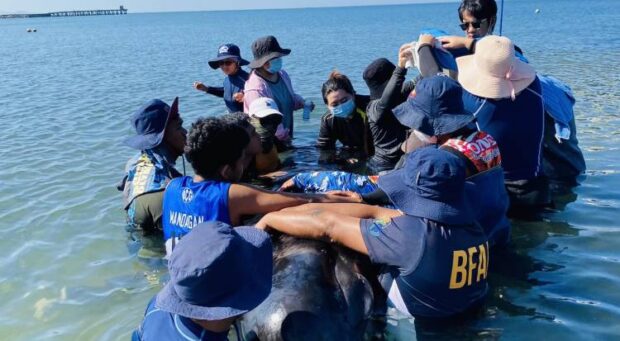In Ilocos Sur, rescuers mourn death of pilot whale

VALERIE’S ANGELS | Bureau of Fisheries and Aquatic Resources (BFAR) personnel and volunteers work together in this photo taken Feb. 13, 2924, to keep “Valerie,” a female adult short-finned pilot whale, afloat in Narvacan, Ilocos Sur, after she lost her natural buoyancy due to unknown trauma. Despite their efforts, the whale died on Saturday, Feb. 17. (Photo by HASMIN CHOGSAYAN/ BFAR Region I)
DAGUPAN CITY, Pangasinan, Philippines — The staff and volunteers of the Bureau of Fisheries and Aquatic Resources (BFAR) in the Ilocos Region mourned the death of a rescued short-finned pilot whale after a week of trying to keep it alive.
The female adult whale they lovingly named Valerie was found by fisherfolk beached in Sta. Maria town of Ilocos Sur on Feb. 10. It was still unknown how and why the whale was stranded there.
Valerie appeared to have lost her buoyancy or ability to float, which would have meant instant death for her at the bottom of the sea where oxygen is scarce and pressure is greater.
With the help of BFAR’s trained marine mammal stranding staff and volunteers from other agencies and private organizations, Valerie underwent 24-hour medical care for a week where teams held her and kept her afloat while she was being treated.
But Valerie was unable to hold on and died in the arms of volunteers at 1:45 a.m. on Saturday.
Article continues after this advertisementSuspected cause
BFAR veterinarian Hasmin Chogsayan said Valerie was already weak in the early evening on Friday. But the volunteers refused to let go of her even as her breathing gradually slowed down and then stopped.
Article continues after this advertisementValerie, who was 3.4 meters long and more than 500 kilos, was found with fresh wounds near its peduncle (large muscular area between the dorsal fin and the flukes), Chogsayan said.
Chogsayan said in a phone interview on Saturday that a necropsy was being done to find out what caused the marine animal to beach and later die. But she said they initially suspected it was due to blast fishing.
READ: Blast fishing eyed in stranding of whales, dolphin in Ilocos
In a social media post on Saturday, the Philippine Marine Mammal Stranding Network said the “job of keeping [Valerie] alive may be sadly over, but the job of finding out why is just about to begin.”
Chogsayan said even if Valerie survived, she could no longer be released to the wild as she had also lost her sense of hearing and could not echolocate anymore.
Echolocating is the ability of some marine and land animal species to locate distant or invisible objects (such as prey) by sound waves reflected back to them from the objects. Without the ability to echolocate or echolocation, marine mammals lose their way in the sea, making hunting for food impossible.
Valerie was supposed to be taken to live at Ocean Adventure at Subic Freeport in Bataan.